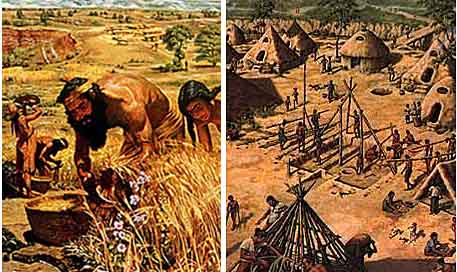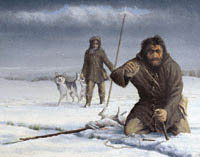Activity 1
Essential Question
- Why have civilizations changed slowly over time with more rapid changes occurring during the modern era?
Background Information
Modern humans appeared about 40,000 years ago. They lived successfully in small nomadic hunting and gathering bands until around 10,000 years ago when agriculture began to gradually replace hunting and gathering as the dominant way of life.

The rise of agriculture allowed for the
development of more complex societies
The transition to agriculture was a critical trigger for the development of more complex societies since it allowed people to establish permanent settlements and live together in far greater numbers than ever before.
Instructional Strategies
 |
Strategy 1 |
Gathering Information: Using Pictures and Pictographs
Use the following website to give students an understanding of the slow pace of change prior to the emergence of modern Homo sapiens about 40,000 years ago.
http://www.pbs.org/wgbh/aso/tryit/evolution/indext.html
Talk with students about the importance of gathering information about a topic prior to drawing conclusions. Use the KWL Chart to record what you already know about prehistoric people.
Use the following website to show students pictures about hunting and gathering civilizations. Use the guide questions to ensure that students get as much information from the pictures as possible.
http://www.wsu.edu/gened/learn-modules/top_agrev/3-Hunting-and-Gathering/hunt-gathering1.html
Guide Questions: The U. S. National Archives and Records Administration suggests three steps to help students analyze photographs.
Step 1: Observation
- Overall impressions
- Details in each section of the photo (people, objects, activities)
- What can you infer from the photograph?
- What questions does the photo raise in your mind?
- Where could you find answers to your questions?
Ask students to look more carefully at the pictures and draw inferences from what they see.
- What can you infer from what you see in the pictures?
- Why are these logical inferences?
Have students refer back to their KWL chart.
- What information is confirmed by the pictures?
- What information is challenged by the pictures?
Now have the students go to the Internet to collect a group of their own images of historical and modern hunters and gathers using such key words as:
- Hunter/gatherer
- Prehistoric people
- Bushmen
- Aborigines
- Pygmies/Itruri Forest People
- Native Americans
- Foragers
Have students review the guide questions for analyzing pictures. Have them use these strategies as they examine their own set of images. Ask more specific questions to help students see the relationships among the pictures:
- What do all these pictures seem to have in common?
- In what parts of the world do the people in these pictures live?
- In what time period do you think they live?
- What kind of clothing do you observe these people wearing? Why do you think they wear this type of clothing?
- In what kind of homes do you think these people live?
- What do you think these people do for a living?
- What kinds of foods do you think they eat?
- What kinds of transportation do you think they use?
- Would you want to live a similar lifestyle to these people? Why or why not?
Using the new information gained from the discussion, have students go back to their KWL chart and fill in what they have learned.
Check for Understanding
Use the essential question to determine how much student thinking has expanded?
- Why have civilizations changed slowly over time with more rapid changes occurring during the modern era?
 |
Strategy 2 |
Extending and Refining Information: Using Timelines and Video Clips
Create a timeline of human history that spans 40,000 years. This can be done in a variety of ways.- Marked adding machine tape or rope can be stretched out to illustrate the time span.
- A very long hallway can be used with the tiles on the floor representing intervals of time.
- An athletic field with yard markings may be used in the same way.
Position students at points representing the beginning of the timeline (40,000 B.P.), the transition to agriculture (10,000 B.P.), and today. Talk about the relative distances of the students.
Use the Internet or the textbook to look for examples of completed timelines. For example, students could print out the timelines from the following site for use in this activity:
http://www.infoplease.com/ipa/A0001198.html
Ask students to look for events on the timelines that they think were as important as the transition to agriculture in 10,000 B. C. Use a timeline such as this one to record five events you think are as important as the agricultural revolution:
List all events on chart paper and after class discussion, have the students star the top five events. Extend student thinking about the magnitude of the agricultural revolution by asking the following questions:
- Why do you think these events are equal in importance to the agriculture revolution?
- What changes occurred as a result of these “revolutions”?
- Why are these events closer together on the time line?
Use the timeline to help students scaffold their thinking. Begin with factual questions then extend and refine their thinking to encourage higher levels of thinking. For example:
- For how much of history did humans spent as hunter gatherers?
- Why did humans maintain this way of life for so long?
- When humans transition to agriculture as a way of life, what happens to the pace of events on the timeline?
- What do you think accounts for the change in the pace of events?
Check for Understanding
Students should discuss these essential questions:
- Can change happen too quickly?
- What are some of the problems associated with rapid change?
- Is society becoming too complex?
 |
Strategy 3 |
Application: Transfer
Have students review their KWL Charts and their notes. Discuss the rapid change in society after 10,000 B. C.
Have students predict the next event on the timeline which could be considered a revolutionary change, altering the way people live. Use these questions to help you predict what life might be like after your next event on the timeline.
- What technologies might drive the next revolution?
- In what parts of the world will these technologies be most evident?
- What kind of clothing do you observe these people wearing? Why do you think they wear this type of clothing?
- In what kind of homes do you think these people live?
- What do you think these people do for a living?
- What kinds of foods do you think they eat?
- What kinds of transportation do you think they use?
- Would you want to live a similar lifestyle to these people? Why or why not?
Check for Understanding
Summarize this discussion by having students write an essay about what life might be like in this new era. Have them decide if life will be better in this era and to support their decision with information from the class discussion. Before they begin to write, review these thought questions with them:
- Can change happen too quickly?
- What are some of the problems associated with rapid change?
- Is society becoming too complex?

 Module Menu
Module Menu Printable View
Printable View

